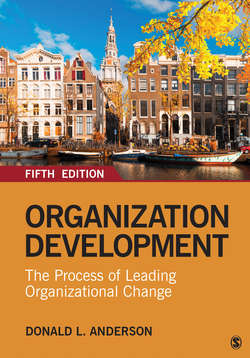Читать книгу Organization Development - Donald L. Anderson - Страница 73
На сайте Литреса книга снята с продажи.
Weisbord’s Six-Box Model
ОглавлениеStrictly speaking, Weisbord’s Six-Box Model, first elaborated in a 1976 article, was not explicitly articulated as a model of organizational change (see Figure 4.5). In later years, however, Weisbord’s model has become a popular diagnostic model to illustrate elements of a system that are out of sync with other parts of the system, in particular to explore how formal and informal systems are often misaligned or contradictory. Consequently, it has become a popular model among practitioners for analyzing and conducting organizational change (Birnbaum, 1984; M. W. Ford & Evans, 2001).
Weisbord refers to the model as a “radar screen” (Weisbord, 1976, p. 431) depicting the interrelationships among six of an organization’s component parts. Based on his experience, the model categorizes six common problem areas in an organization and helps to illustrate how symptoms can be seen in a systemic light. Each of the boxes has both formal (espoused and official) and informal (how things work in practice) components, and a complete diagnosis must attend to both. The model’s six boxes are as follows:
Purposes. This box includes formal goal clarity (how well the goals are explained) and informal goal agreement (how well the goals are truly understood and acted upon).
Structure. How well does the organizational structure match the needed outputs? Is the organizational structure followed or undermined in daily practice?
Rewards. Does a (formal) reward system exist, and does it actually produce results, making employees feel as if their contributions are being rewarded (informal)?
Relationships. This concerns the degree to which people can work interdependently and manage conflict successfully.
Helpful mechanisms. What formal mechanisms exist to facilitate work, such as budget processes, meetings, reviews, or other communications? How well do these helpful mechanisms meet their objectives?
Leadership. How do leaders lead? What do they state as their formal expectations? What norms do leaders informally role model or informally communicate?
Description
Figure 4.5 Weisbord’s Six-Box Model
Source: Weisbord, M. R. (1976). Organizational diagnosis: Six places to look for trouble with or without a theory. Group & Organization Studies, 1, 430–447. Reprinted with permission.
When formal and informal components of the boxes are not in alignment, the organization may be expending energy maintaining both a formal system and an informal one that may or may not be functioning as needed. It is not the case that one of these systems is better than the other, but understanding how these six boxes function formally and informally can give insight into why an organization may be experiencing problems and where to begin interventions for change (Weisbord, 1976). Additional gaps may exist between the organization and its environment, between individual work and the organization’s goals, or between different organizational units. It is this formal and informal gap analysis that Weisbord and others have noted is an especially important aspect of the model. Weisbord’s Six-Box Model thus gives great insight into the internal functioning of a system. As some have noted, this advantage of the Six-Box Model may be its drawback as well, as it attends less to elements of the external environment and issues such as scarce resources or demands of external stakeholders (M. I. Harrison & Shirom, 1999). It also gives less insight into which gaps may be more serious than others. By placing leadership in the center of the model, it may also overemphasize the role of leadership and understate the role of individual employees in the functioning of the organization.
This model, like the other three models, is consistent with the approach suggested by systems theory, that an organization exists in interaction with its environment, and that managing problems, misalignments, and holes between various components is a key to successful organizational functioning. This has been the dominant approach in OD and organization theory (Shaw, 1997). Assumptions about organizational components and analysis of “fit” remain a key feature of diagnostic recommendations in the practitioner literature (e.g., M. I. Harrison & Shirom, 1999). This approach can be enhanced, however, by another perspective, to which we now turn.
